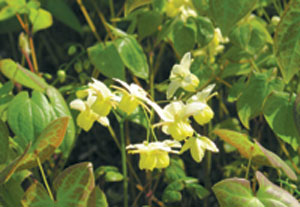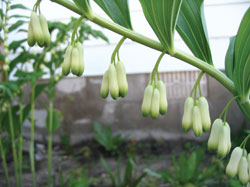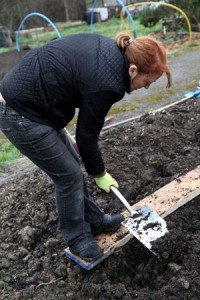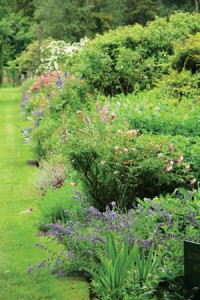Perennial Passion
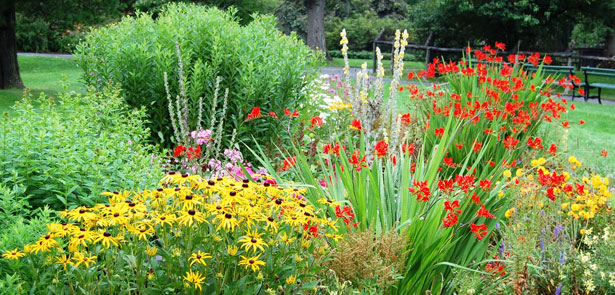
Cultivate a passion for long-lived perennial plants this autumn. We explain the joys to be had from this hard- working group of plants and share some of our favourites
This time of year is downright glorious thanks to its spectacular autumnal hues. And when illuminated still further by a sun sitting low in the sky the effect is nothing short of invigorating. But it can also be a melancholic time: nights are drawing in, the first frosts of the season have or are about to strike, while summer’s teeming life is turned to wintry slumber. Colder weather is back in charge and nature is going about a transformation as she prepares to hibernate until spring. You might conclude therefore that there’s very little other than tidying up to be done in the garden. But you’d be wrong.
Early to mid autumn is, in fact, the very best opportunity to introduce new plants to the garden. This may sound perverse when existing plants are shrugging off their leaves to reveal their naked stems, yet there’s sound logic behind this. Dig a hole a foot or so deep and touch the soil at the bottom – it should still be warm from summer. This latent warmth comes at a time when the soil is moist and the strains of the growing season are behind us. Plant now and the roots of your new garden arrivals will be encouraged to settle down and root into the surrounding soil before the really cold weather sets in. By doing this they will have a cracking start to next year’s growing season.
Year-To-Year Pleasure
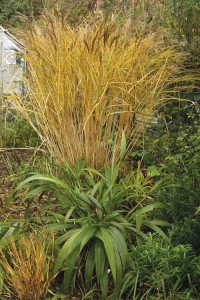
Tall grasses such as this miscanthus look great even in death with their fountain of leaves and, below, their feathery seed heads
Pic Credit peganum
Many of us grow bedding plants and other annuals over the warm months. They provide a bold splash of colour and brighten anyone’s day. The downside is that their impact is fleeting and now you will no doubt be clearing the exhausted plants to the compost heap. Perennials, on the other hand, are long- lived plants that keep going from one year to the next; plant once and you can expect many years of pleasure. These plants pay back much more than annuals over the seasons – and they don’t ask for that much maintenance in return. Now’s the time to plant them!
Unlike annuals or biennials (plants that last for two seasons), perennials should last a number of years. The exact lifespan varies from plant to plant and according to the conditions they are grown in, but the majority will be around for at least five to seven years and some will continue growing for decades. Almost all perennials are very easy to propagate when they do start to look past their best, which means you only have to plant once to enjoy a perennial for a lifetime – given a little know-how of course.
Hardy perennials will be on sale in local garden centres and nurseries for planting this autumn. Hardy perennials are, as the name implies, tough as old boots, surviving winter frosts and snow to sprout back into life the following spring. Some perennials, such as the large and leathery-leaved elephant’s ears (Bergenia) are evergreen, holding onto their leaves to provide structure during even the coldest months. Others are deciduous, dying right back to ground level every autumn and emerging once again into the soft light of spring.
Some perennials are technically deciduous but can be left standing over winter, even after they have died, to provide atmospheric, almost ghost- like tones. Many of the taller ornamental grasses (including, for example, varieties of Miscanthus and Calamagrostis) look really fantastic left like this, as do the seed heads of Joe Pye weed (Eupatorium purpureum) and any of the daisy- like heads of plants like rudbeckia or echinacea. Plants such as this left standing over winter will add architectural accents to an otherwise drab garden. Cut them back in February to allow the new shoots room to push through.
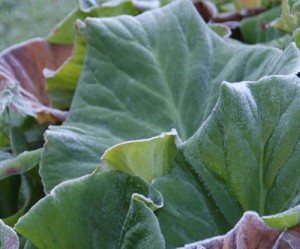
These frost-rimed leaves of the elephant’s ear will turn crimson as the winter progresses
Pic Credit to ripplestone garden
Right Plant, Right Location
Deciding what to grow and where to plant it depends primarily on the conditions you have in your garden. Most perennials will prefer well-drained yet moisture-retentive soil that does not get waterlogged in winter (or summer!). The majority also prefer a sunny part of the garden. Nevertheless, with so many thousands of perennials to choose from there really is something to suit your situation – even if it’s a spot in clay soil that get’s baked hard in summer and drowned in winter; it just means the palate of plants you have available will be slightly smaller. Finding perennials that prefer a sunny spot in ideal soil conditions is easy, so here are a few suggestions for those who don’t have this perfect scenario.
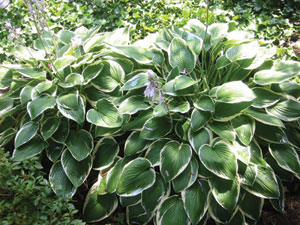
Hostas, such as ‘Francee’, will form generous clumps in a shady spot
Pic Credit to Terren in Virginia
The biggest complaint is shade. If you have a patch in shade worry not – you have, in my humble opinion, some of the most delicate and sophisticated perennials of the lot! Try any of the beautifully luxurious hostas, such as the white-margined variety ‘Francee’ which bears its lavender- coloured flowers in summer. Or how about the nodding red, orange and yellow blooms of columbine or granny’s bonnet
(Aquilegia formosa) – enough to add a citrusy splash in even deep shade. Perhaps my absolute favourite for its combination of fine tooth-edged leaves and dainty sprays of flowers in every tone from pale yellow to deep pink is the barrenwort or bishop’s hat (Epimedium). Best of all the leaves of this ground covering plant take on bright copper colours as winter approaches.
Other shade-lovers worth seeking out include the spires of foxgloves, lime-green flowering lady’s mantle (Alchemilla mollis – a plant that’s equally happy in full sun), phlox, primulas and the crystal-white string of bells that make up the flowers of Solomon’s seal (Polygonatum x hybridum). The list goes on!
If your soil is often waterlogged or if you are looking for perennials that would grow well by a stream then first in the queue are the astilbes, commonly known as goat’s beard. The flowers, usually in creamy white or shocking pink, tower in airy plumes above fern-like foliage. This stunner might look good teamed up with some of the strap-leaved irises that can cope with wet conditions, including blue- flowering Iris sibirica or I. laevigata.
Painter’s Eye
Take your time researching suitable perennials for your patch of ground. This is crucial! They will be with you for a long time, so it’s worth taking the time to plan out what you might grow, though even perennials can be moved to a new home if you change your mind in the future or if the area you planted them in turns out not to be ideal.
Assuming the plants are fit for the spot you have in mind, the next consideration is how they will fit into their surroundings. This is where a painter’s eye comes in handy. You will need to consider the ultimate height and spread of the plant – will it overshadow or muscle in on its neighbours? Tall plants near the front of the border will clearly obscure those at the back, though one or two taller plants bursting out from a lower level of planting can look dramatic. Think about the colours and textures of the plants. When choosing a new plant for an existing border you probably want it to fit in and look like it’s meant to be. Flowers in the same colour or in a similar tone will blend in beautifully, while a colour of complete contrast can shock and make a statement. Leaf textures are also important. Grasses can help to break up a sea of traditional perennials, adding movement and sound as the wind blows through them. Some plants are worth growing for their leaf texture alone – the flowers a bonus or insignificant sideshow. Examples include he silvery leaves of mugwort (Artemisia ‘Powis Castle’) or the spiky show-off that is cotton thistle (Onopordum acanthium), though this also happens to have the gorgeous cushion- like purple thistle blooms.
Preparing The Ground
Proper ground preparation at planting time is the secret to establishing a healthy plant – whether it be a shrub, climber or, indeed, perennial. The first task is to remove all weeds which will compete with your new introduction for light, nutrients and water. Take special care to lever out deep roots or perennial weeds, as any scraps of root left behind have an annoying habit of sprouting new shoots.
Dig the ground where you want to plant, incorporating some well-rotted organic matter as you go; garden compost or very well-rotted manure is just fine. Some gardening books will advise you to add this organic matter into the planting hole itself but in my experience it is best to spread it over the wider area and dig it in. By doing this roots will be encouraged to spread out into the surrounding soil to seek out the nutrients contained within it. The structure of the wider area will also be improved in this way.
If you want to add one last fillip of fertility to boost your new plants mix in a handful of bone meal, available from any garden centre, into the bottom of the planting hole. Bone meal is high in phosphorus, which naturally encourages root growth – just what we need when planting at this time of year.
Planting Time
With the ground nicely prepped you can now go about the best bit: planting! First position your plant, still in its pot, on the soil surface to check whether it has enough room and looks balanced where it is. If you are planting an entirely new border from scratch and you have many different pots then spend a while carefully re-jigging your arrangement until it’s just so, bearing in mind, of course, the final spread and height of the plants.
Once you are satisfied you’ve got it right, dig a planting hole for each plant. This should be about twice as wide, and a little deeper, than the pot itself. Carefully remove the plant from its pot (a gentle tap at the top of the pot when it’s upside-down usually eases it free) and tease away some of the roots, particularly if the roots are spiralling around the outside or have formed a thick mat (a plant in this situation is said to be ‘pot bound’). Pop the plant into its hole and feed the soil back into the hole, pushing it into the sides with your fingers. Check that the top of the rootball is level with the soil surface, adding or scratching away soil as necessary.
Now firm the soil around the plant by pushing it down with the heel of your foot. This removes any remaining pockets of air and ensures that the rootball will have good contact with the surrounding soil, helping it to root out into it quicker. After a final check, give each plant a really thorough watering, puddling it in to settle the soil even further. At this time of year plants shouldn’t need another watering until spring but, nevertheless, after such a wet summer a dry autumn could be on the cards, so don’t rule it out.
Depending on what you have planted, the foliage may die back for winter. But just wait until next spring when those new shoots appear with eager vigour. By next summer your perennials will have firmly established, ready to take on the world and thank you with their unique qualities.



